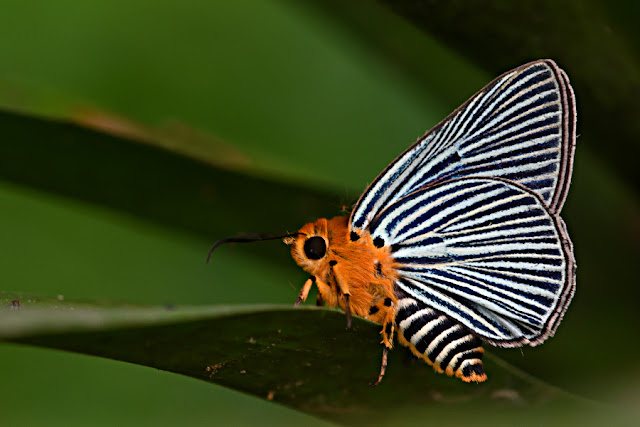I am going to share mainly butterfly species that I have encountered from 9 - 16 Oct when I was with Antonio. Our main butterfly-hunting grounds were in Chiang Dao, Mount Suthep, Mount Inthanon and Mae Kampong.
I was very fortunate to meet up with Andy Ho from Hong Kong in Chaing Mai and we had a good time shooting together at Doi Suthep on 16 Oct.
I will begin with skippers - most of them were photographed at Chiang Dao foothill puddling ground where a parking area is. I hope and appeal to the authority there that they will not cover it up with concrete cement!
Skippers belong to the butterfly family Hesperiidae. They usually dart at high speeds and many of them are quite small and don't usually attract our attention. However, there are many cute-looking and interesting skippers. For examples, the Common Orange Awlet (Burara harissa) looks chubby - a rather common species as it was spotted at a few different locations.
Awlet and Awl skippers have the habit of coming out early in the morning or late in the evening. This Green-streaked Awlet (Burara amara) was shot in a late evening at a dark corner at Chiang Dao.
Many macro-photographers love Choaspes species because their 'outfits' are attractive. They are usually alert and it is challenging to photograph them as well as identify them with confidence. This guy looks like The Formosa Awlking (Choaspes benjaminii) which was super alert and active when feeding on flowers.
Here is another interesting skipper. This is the Tiger Hopper (Ochus subvittatus) - though a tiny skipper, the black spots on both the yellowish upper wings make it quite prominent.
There are quite a number of skippers having yellowish or orangey 'outfits' - The Golden Ace (Thoressa masoni ) is rather common.
Skippers in the Pothanthus genus looks similar - this mating pair is likely to be the P. mingo - female is on the left.
Next set of skippers blend very well with the ground - to spot them puddling needs our full focus and good eyesight. This is the Light Straw Ace (Pithauria stramineipennis stramineipennis).
The head section of the Arnetta atkinsoni is a lot more triangular in shape.The Halpe species can be quite difficult to identify with certainty. This looks like the Halpe filda.
Another common skipper the Pale Marked Ace (Halpe hauxwelli).
You can notice that the close resemblance of the dotty markings on different skippers - this is The Silver-breast Ace (Sovia albipectus).
The Grass Dart (Taractrocera maevius) surely looks very similar to the above Silver-breast Ace.
If we are not careful enough, we can easily mix up the next three Ace's. The Northen Ace (Thoressa cerata) has a prominent white spot near the base of the hindwing.
The Moore's Ace (Halpe porus) is quite common instead.
Some skippers tend to perch on foliage more often then to puddle on the ground.This is a Koruthaialos species.
This dark brown and relatively large skipper is the Restricted Demon (Notocrypta curvifascia) - it was spotted at a few locations.
The Starry Bob (Iambrix stellifer) presented a nice perch on a leaf that I could not resist taking a few shots.
Two White Palmers (Acerbas anthea) appeared in the morning outside our accommodation. Both were very active and uncooperative for me to get better shots.
We can find skippers that tend to perch flat on or beneath the leaf surface. This is the Water Snow Flat (Tagiades litigiosa). Can you spot the difference between the Spotted Snow Flat (Tagiades menaka menaka) ?
Both Flats were shot at Doi Suthep.The Large Snow Flat (Tagiades gana meetana) came out for sunbathing at Doi Suthep.
We have a different subspecies of the Yellow Snow Flat (Mooreana trichoneura) in Malaysia and Singapore. The pralaya subspecies here seems to have a larger yellow patch on the hindwings.
Another unattractive and 'boring' Common Snow Flat (Tagiades japectus).
The Yellow-Banded Flat ( Celaenorrhinus aurivittatus) loved feeding on wild flowers, making it easier for us to snap a few shots.
Among the spread-winged skippers in Singapore, we have only two Gerosis species but they are very rare. In Thailand, they are rather common. This is the Common White Flat (Gerosis bhagava bhagava ) - unsettled at first but it decided to sunbathe when the sun was up.
The Variable White Flat (Gerosis phisara phisara ) was quite active while feeding, changing perch very frequently.A long distance shot this time, the Hairy Angle (Darpa hanria) preferred to stay far away from us.
The Fulvous Pied Flat (Pseudocoladenia dan fabia) was spotted a few times at different locations in Chiang Mai. The underside shot was taken late in the afternoon.


To be continued









































